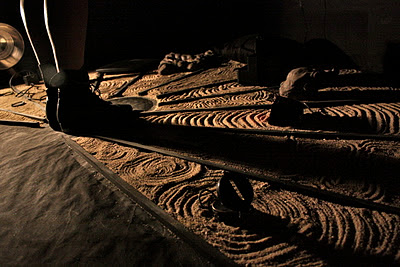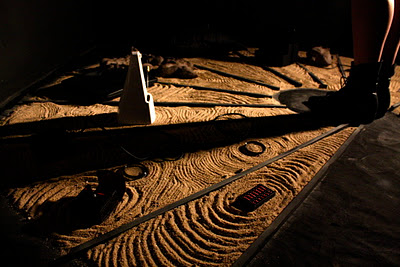Assignment: Site-specific collaborative installation
visual thought process:
Sitting in my basement studio at 3am trying to finish my drawing homework under fluorescent light, I mused at what effect this might be having on my circadian rhythms.
Although circadian rhythms are endogenous ("built-in", self-sustained) in all plants and animals, they are adjusted to the environment by external cues called zeitgebers. The primary one of which is daylight, but they can be offset by artificial light. Circadian rhythms dictate clear patterns of core body temperature, brain wave activity, hormone production, cell regeneration and other biological activities.
Inspired by the human sundial, and our electrical era's degeneration of circadian rhythms, my collaborative partner and I began to piece together our installation in our basement studio.

Assignment: create a portrait or a narrative that involves a container or is contained
I chose portrait. A portrait of "my" culture. I found this discarded television on the side of the street, and thought, here is a container, a confinement--of the current mental state of this media-soaked culture. And then, what could I do to change its meaning? To contest this confinement?
visual thought process:
Olafur Eliasson -The Weather Project
Tate, London (2003)Curated by Susan May
The subject of the weather has long shaped the content of everyday conversation. In The Weather Project, the fourth in the annual Unilever Series of commissions for the Turbine Hall, Olafur Eliasson takes this ubiquitous subject as the basis for exploring ideas about experience, mediation and representation.
In this installation, representations of the sun and sky dominate the expanse of the Turbine Hall. A fine mist permeates the space, as if creeping in from the environment outside. Throughout the day, the mist accumulates into faint, cloud-like formations, before dissipating across the space. The ceiling of the Turbine Hall has disappeared, replaced by a reflection of the space below. At the far end of the hall is a giant semi-circular form made up of hundreds of mono-frequency lamps. The arc repeated in the mirror overhead produces a sphere of dazzling radiance linking the real space with the reflection. Generally used in street lighting, mono-frequency lamps emit light at such a narrow frequency that colours other than yellow and black are invisible, thus transforming the visual field around the sun into a vast duotone landscape.
http://www.tate.org.uk/modern/exhibitions/eliasson/about.htm
I too, was interested in light and the relationship between people and the weather, but I was focused on the way that people have created a concept of time that revolves around the sun.
The sundial is the oldest known device for the measurement of time and the most ancient of scientific instruments.
...and the way that people have tamed light to manipulate it according to their desire, rather than according to natural cycles of sunlight that our bodies have evolved with.
Sitting in my basement studio at 3am trying to finish my drawing homework under fluorescent light, I mused at what effect this might be having on my circadian rhythms.
Although circadian rhythms are endogenous ("built-in", self-sustained) in all plants and animals, they are adjusted to the environment by external cues called zeitgebers. The primary one of which is daylight, but they can be offset by artificial light. Circadian rhythms dictate clear patterns of core body temperature, brain wave activity, hormone production, cell regeneration and other biological activities.
Inspired by the human sundial, and our electrical era's degeneration of circadian rhythms, my collaborative partner and I began to piece together our installation in our basement studio.

The viewer enters the space in complete darkness, and is guided to stand in the center of the dial. The first light comes on, along with an electric hum, and the first mark on the dial is blackened with the viewer's shadow. One by one, each light is clicked on and off to the beat of a metronome that appears on one of the marks in the dial, until the viewer's shadow makes a complete travel to the other side of the dial, having gone through an entire virtual day in under a minute. The lights and sounds are turned off, and the viewer is guided out of the space in darkness.
Assignment: create a portrait or a narrative that involves a container or is contained
I chose portrait. A portrait of "my" culture. I found this discarded television on the side of the street, and thought, here is a container, a confinement--of the current mental state of this media-soaked culture. And then, what could I do to change its meaning? To contest this confinement?

Growing up, I was told to run along and play outside instead of sit in front of the tube all day. For this I cannot express my gratitude, and as a result I think I am a much fuller, dynamic, and curious person than I would have been with the false reality of the TV screen as my model for life. I instead became enthralled with the endless adventure I found outdoors, no mind the limited ecosystem that found room to thrive within my suburban neighborhood.
My sculpture became a plea for a more tangible form of stimulus, in young minds and in all minds, but especially the minds of my own culture which I am placed into by region, time, and chance.
This television is left unplugged, and with its abstract yet recognizable forms inside the viewing box, I hint at the necessity for a new reality.








































